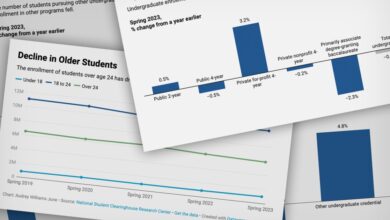The Homework Tax

[ad_1]
The second in a three-part series about courseware. Part 1 is here.
The 27-year-old, who graduated in May from Houston’s Lone Star College-University Park after more than seven years of study, was trying to beat the clock: a 14-day free trial of McGraw Hill Connect, a courseware product. When that didn’t work, she withdrew from one course and failed out of the other, unable to afford the more than $100 cost apiece.
Thomas was making only about $200 every other week from part-time work-study — much of which was immediately funneled to essentials like food, phone bills, and bus cards. So she had to find other options, hunting for courses with low-cost or free materials, or those where professors opened up all assignments on Day 1.
Experiences like these “made me feel embarrassed … like I wasn’t doing enough,” she said. “It was stressful.”
In the past decade, as the print-textbook market has become less profitable, publishers like Pearson, Cengage, and McGraw Hill have increasingly shifted to digital offerings like courseware. That market has ballooned, with those three companies’ flagship courseware tools collectively reaching millions of users annually. Costs vary depending on the subject and publisher arrangement, but in STEM subjects, especially, the price of a courseware product can exceed $200.
For proponents of courseware, it’s just another material cost, and one that’s worth the price tag for the additional practice and immediate feedback the tools provide. But critics argue that there are essential, ethical differences between these tools and other course materials.
Their argument is multifold: For one, they say, products like these — which often deliver key elements of a course that an instructor would typically be responsible for, like homework, assessments, and grading — should not be the student’s burden. At least one student advocate said colleges, rather, should cover or subsidize the cost, as they do with software like learning-management systems, if they’re allowing faculty free rein to adopt the products.
“Courseware has become more central to the operation of the class” and is less a supplement in the way the textbook has historically been, said Richard Hershman, the vice president for government relations at the National Association of College Stores. “That’s where some of the debate occurs around, ‘Why am I paying more for this?’”
And the fact that students’ access to these products expires — sometimes after just a semester — rubs salt in the wound, and risks further disadvantaging students.
The rise of courseware, skeptics argue, flies in the face of efforts by both student-advocates and legislators to make college more affordable. “Students are seeing less and less opportunity to support themselves and get a meaningful return on investment,” said Sheneese Thompson, an assistant professor of English at Bowie State University, in Maryland. That is “troubling to me.”

Sam Green for The Chronicle
Over that same period, publishers have rolled out courseware products that require subscriptions or access codes. Remaining profitable in the higher-education market, after all, does remain integral to their bottom lines. At Pearson, the U.S. higher-education sector generated about a quarter of the company’s more than $4.7 billion in revenue in the 2022 fiscal year (the most recent earnings figures available at the time of publication). At Cengage, in the 2023 fiscal year, higher education accounted for 40 percent of the company’s $1.5 billion in revenue. McGraw Hill reported that nearly one-third of its total “billings” for the 2023 fiscal year — commonly defined as invoices sent to customers — came from the sector.
These products are notably different from traditional textbooks in ways that extend beyond just the scope of services. Notably: Courseware must be purchased new, can’t be shared or resold, and is often essential to passing a class.
Once a student purchases and activates their courseware, it’s available to them for a limited period of time. (One of the most common lengths publishers reported is 180 days.) Publishers’ terms-of-service and terms-of-use agreements reviewed by The Chronicle make explicit that the products are for individual use. That restriction is hard to circumvent; the products are often integrated directly into campus learning-management systems and linked to each student’s gradebook.
In certain cases, it may be feasible to forgo courseware and still perform well in a course. Some instructors have used it for extra credit or pre-lecture assignments that count for 5 to 10 percent of the grade. But often, students face a stark calculation: Buy the courseware or sacrifice their grade — even fail outright.
A psychology instructor’s syllabus that The Chronicle found online, for example, noted that 26 percent of a student’s final grade is homework completed in Cengage MindTap. In an online intro-to-accounting course at Rio Salado College, 48 percent of the grade is Pearson MyLab assignments and assessments. Older case studies from McGraw Hill Connect have cited percentages as high as 94.5 percent.
Matthew Regele, an assistant professor of management and entrepreneurship at Xavier University, in Ohio, used to work for a major publisher before the pandemic, and spent 15 months observing how it operated its business and developed products, before publishing a peer-reviewed research paper on his findings. (Regele did not identify the publisher in his paper or to The Chronicle.) A key tenet of maintaining profitability was “to get every student paying every semester,” Regele said in an interview. “And digital does that — especially if we hook it to the grade. … I heard that up to at least vice-president level people.”
Officials at McGraw Hill argued that their products can’t be shared or resold for good reasons. Courseware like Connect is a “dynamic” learning tool that adapts based on what an individual student needs, said Kent Peterson, senior vice president and chief marketing officer for the company’s higher-education business unit. “This isn’t something that was created just because we want to foil used books.”
As for the limited use? Unlike a textbook, “If I give you a digital product and say, ‘You can have that forever,’ I have to support that forever and ever” with continued investments and updates, even though the user paid for it just once, said David Duke, chief product officer for McGraw Hill’s higher-education business. “It’s basically impossible.”
Regardless of publishers’ reasoning, for Thompson, at Bowie State, the subscription-based approach to student course materials is an existential threat to the “student economy.” In that economy, students can rent and return used books for a fraction of the original price. They can swap and share books with each other. They can buy and then resell books.
“It used to be very feasible for students to say, ‘I’ll make the upfront investment [on a textbook], knowing that I can get at least 60, 75 percent of that investment back,’” she said. “You can’t do that with courseware.”
Questions about digital equity also arise, given that not all students will meet the tech requirements to use courseware as effectively as their peers. Disparate access to digital tools like laptops and Wi-Fi, which made headlines during the pandemic, remains a notable barrier for many students. In a June report from Tyton Partners, an advisory firm focused on the education sector, 79 percent of more than 1,500 student respondents said they’d experienced unstable internet connections. Nearly 40 percent said they’d had an experience of not having a device (computer or laptop) that they needed for class.
All three major publishers’ courseware products require a stable internet connection. Representatives for Pearson and McGraw Hill also confirmed that their courseware can’t fully run on a mobile device. A spokesperson for Cengage wrote in an email that users “can access MindTap from a mobile device using their browser” but did not clarify whether all features are accessible that way.
Publishers said courseware prices depend on numerous factors, including whether additional product features are needed, like lab activities or Excel software. They also underscored that options exist at the student, course, and institutional levels to lower the cost to students.
At the student level, for example, if a learner ends up having more than one course that requires Cengage courseware, they could purchase an unlimited subscription for a flat rate of $125 a semester, a spokesperson wrote in an email.

Further Reading
At the instructor level, officials at McGraw Hill said they work with faculty to understand their goals and objectives, and if courseware doesn’t seem like the right fit, they’ll recommend purchasing just the eBook — a lower-cost solution that can amount to as little as $30.
At the institutional level, Pearson pointed to “inclusive access” arrangements, in which a college works with a publisher to offer courseware products to students at lower rates. Texas A&M University at Commerce, for example, has an inclusive-access arrangement with Pearson that, as of summer 2023, gave participating students in the math department a discount on MyLab of roughly 38 percent, bringing the cost down to $52.49 from $85.27. (Under such arrangements, the cost is automatically added to an enrolled student’s bill unless they opt out — an approach some textbook-affordability advocates like the Scholarly Publishing and Academic Resources Coalition have criticized.)
Many of these alternative arrangements, though, still don’t sit well with advocates like Janelle Wertzberger. “Be wary of solutions presented by the same people who caused the problem,” said Wertzberger, assistant dean and director of scholarly communications at Gettysburg College, in Pennsylvania, during a March webinar on textbook affordability.
For Montoya Thomas, high course-material costs were key to her decision not to pursue a career she was excited about: physical therapy.
Thomas, who got her associate degree in communications this year, initially became interested in physical therapy in middle school, when her foster sister broke her leg playing volleyball. During her sister’s recovery, Thomas would walk alongside her, offering encouragement as she adjusted to getting around without crutches. Maybe I should do something like this, Thomas thought.
But it became quickly apparent that the STEM courses and labs she’d need to take, many of which required courseware products, weren’t financially tenable, she said. “So I had to let that go.”
John Runningen had moments when he questioned his place in higher education altogether. The first-generation student, whose parents weren’t able to contribute toward his education, attended college locally, at Minnesota State Community and Technical College at Fergus Falls, to shave costs. On at least one occasion, he took a synchronous course instead of an asynchronous one — even though asynchronous offerings worked better with his full-time work schedule — because the latter required a $115 courseware product he couldn’t afford.
“When I fill out the FAFSA, and I get all these Pell Grants … and I’m still not able to afford college, it’s almost a slap in the face,” remembered Runningen, who recently graduated and completed his term as president of the nonprofit student advocacy organization LeadMN. “So when I’m coming across the additional costs and I’m sitting there contemplating whether I’m going to cover groceries this week or pay off my textbook, you really sit there, and you’re like, ‘Is this really for me? Is this something I should be doing to myself?’”
Where students go to purchase courseware can determine how much they pay — at least to an extent.
Often they’re sent to the campus bookstore. Sometimes it’s a matter of legal obligation. A faculty member at a public university in the mid-South, for example, said that while there’s no formal policy, leaders at her institution have “reiterated that we are not permitted to advertise other sources of books” outside of the bookstore because of an agreement with Barnes & Noble. The Chronicle came across similar language in a contract between Barnes & Noble and an institution in the Northeast, the State University of New York’s Onondaga Community College, which stated that the college “shall not accept advertising … or authorize solicitation on campus by any seller of college textbooks and/or course supplies other than the Contractor.”
The campus bookstore can also be an attractive option to students because it allows them, in some cases, to purchase course materials on credit as they wait for their college to disburse any residual financial aid.
That doesn’t mean that it’s always the best deal, though. While Hershman, at the National Association of College Stores, says many campus bookstores “do everything in their power” to lower the cost to students — more than a thousand offer marketplace price-comparison shopping, for example — markups are sometimes inevitable. This is especially true if a publisher doesn’t offer the bookstore wholesale prices.
In such cases, bookstores “either have to sell at a loss” or charge a bit more in order to cover operational costs like labor, bank-swipe fees, and shipping costs, “which sucks,” he said. In reporting, The Chronicle came across instances of bookstore courseware markups as high as 25 percent above the retail cost; Hershman said the more common margin for digital-course materials is between zero and 15 percent.
Peterson, at McGraw Hill, told The Chronicle his company doesn’t automatically offer wholesale deals to bookstores, though it often works with them, alongside an institution, when forming inclusive-access arrangements. Third-party distributors are “a very important player in providing access to materials to students, but they make their own decisions regarding the markup they want to apply,” he said.
(A spokesperson for Pearson replied via email, “While we cannot share the specific terms of our arrangements with retail channel partners, they do earn a margin on sales through their physical or virtual storefronts as is typical for any retailer.” Cengage did not respond.)
While the cost of courseware in particular is not regulated, textbook and course-material costs more broadly are on legislators’ radars. Since 2013, Sen. Richard J. Durbin, Democrat of Illinois, and his co-sponsors have continued to introduce the Affordable College Textbook Act in Congress — legislation that, among other things, would “close a loophole” in the Higher Education Opportunity Act that’s allowed some publishers to sell courseware products as a single bundle only, versus also offering separately priced components.
Textbook-affordability advocates like Sydney Greenway, former president of Pirgim Campus Action at Wayne State University, are also pushing for more “course marking”: A practice where, during the course-registration period, universities disclose information about required course materials, such as the ISBN and retail price, and whether a course is using exclusively free or affordable materials. She identified at least seven states, including Texas and Louisiana, that have passed bills requiring some form of course marking.
Even beyond that, Greenway believes that institutions or departments should have a line item in the budget for courseware — similar to how they pay for tools like the campus learning-management system.
“If there was one site or something that the university itself subscribed to so that students wouldn’t have to bear the cost … I think that’s a really great solution,” she said.
So where’s the disconnect? For some, the price of materials, including courseware, is out of their control. About 26 percent of faculty respondents to a 2022 Faculty Watch survey said they didn’t choose their own course materials. Some are not aware of the price: In that same survey, 36 percent said they either didn’t know the cost of their course materials or knew the cost of only some of them.
Faculty and students may also have differing definitions for “affordable.” A fall 2022 working-group survey of more than 3,000 students across nearly a dozen liberal-arts institutions, for example, asked students what amount they thought was reasonable to spend on course materials for a class. Fifty dollars was the most common response.
Lauryn De George, a senior instructor in the University of Central Florida’s College of Business, said students in her management course pay about $100 for Cengage MindTap through UCF’s inclusive-access model. While cost is always a consideration, she said, when it comes to choosing a quality course supplement, the reality is that “lowest price doesn’t always mean best.” De George added that none of her students have expressed reservations about the price.
One adjunct instructor in the College of Business and Economics at California State University at Los Angeles, meanwhile, has tried to strike a balance between adopting material that helps her as the instructor without burdening her lower-income students.
She uses McGraw Hill Connect for a small portion of her project-management course because it allows her to easily pull from a bank of open-ended questions and case studies — a necessary “time saver” as she balances adjunct teaching with another full-time job. She’d tried open educational resources previously, she said, but the quality wasn’t up to her standards.
The $150 courseware cost has been a problem, though; about a quarter of the 25 to 30 students in her class come to her at the beginning of each semester with concerns.
The solution she’s settled on is not forcing those students to purchase Connect. Instead, she uses the product only for group work. That way, students can work on the assignments together in class — huddled around a laptop, or over Zoom — with just one classmate who has a Connect account formally submitting the assignment on behalf of the group. She then manually enters the other students’ grades into her gradebook.
She acknowledged that this setup runs afoul of the publisher’s terms of service. (The Chronicle granted her request for anonymity to hear a candid description of how she deals with the cost problem.) But ultimately, she said, “I don’t want it to be a barrier for students who are really proactively telling me, ‘I cannot afford this.’” Asked whether her approach ruffled the feathers of students who did pay for the courseware, she said it hasn’t. “I think they are all quite sympathetic to each other,” she wrote in an email.
Others have had success with non-courseware options — even in larger courses. Eric de Araujo, a lead instructional designer at Purdue University who also teaches an introductory philosophy course online with about 100 students, requires two textbooks that together cost about $80 new, and a fraction of that if students opt to rent or buy used. (He’s receptive to open educational resources but hasn’t found any that are a good fit for the way he’s designed his course.) De Araujo then uses a university-created tool, which is free to students, to post and grade assignments.
For him, it’s largely a matter of principle. “I feel like … there is an understanding when you go to college that you’re going to be asked to purchase textbooks. But people don’t come assuming that they’re also going to have to buy a subscription to software,” he said. So the latter has never sat well with him. “I don’t like that kind of feeling.”
Some faculty members have found other reasons apart from cost to steer clear of courseware. One of the most prevalent: Data privacy concerns.
On Thursday, Part 3: “The Textbooks That Read You”
[ad_2]
Source link






